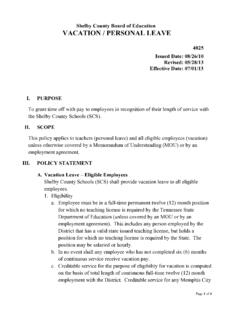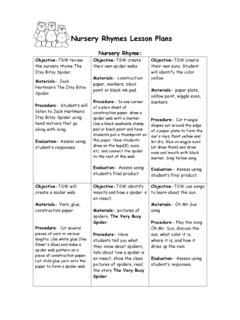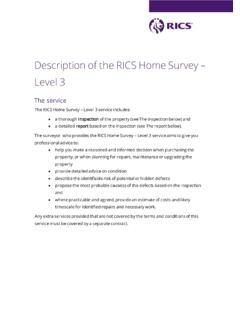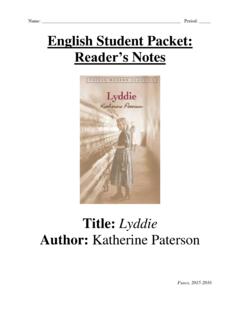Transcription of Learning Progression - Shelby County Schools
1 LESSON OVERVIEWL esson 4b Explaining Relationships in Historical Texts Curriculum Associates, LLC Copying is not permittedLesson 4b Explaining Relationships in Historical Texts66aLearning ProgressionGrade 4 Grade 6 Students explain events, ideas, or concepts in a historical text, including what happened and why, based on specific information in the 6 increases in complexity by requiring students to analyze in detail how a key individual, event, or idea is introduced, illustrated, and elaborated in a text ( through examples or anecdotes). Learning ProgressionGrade 5 Building on Grade 4, students draw on specific details to explain the relationships or interactions among people, events, ideas, or concepts in a historical Saharan Trade Routesby Joris MaddrinGenre: History ArticleThe History and Description of Africaby Leo AfricanusGenre: Eyewitness AccountThe Rise and Fall of Three African Kingdomsby Jo PitkinGenre: History ArticleGuided Practice Curriculum Associates, LLC Copying is not 4b Explaining Relationships in Historical TextsGenre.
2 Eyewitness Accountby Leo Africanus 1 Born in 1485, Leo Africanus traveled across the Sahara to the city of Timbuktu in West Africa. His account provides a glimpse of life there in the early In the center of the city is a and in addition there is a large palace, constructed by the same architect, where the king lives. e shops of the artisans, the merchants, and especially weavers of cotton cloth are very numerous. Fabrics are also imported from Europe to Timbuktu, borne by Berber merchants..3 e inhabitants are very rich, especially the strangers who have settled in the country; so much so that the current king has given two of his daughters in marriage to two brothers, both businessmen, on account of their wealth.
3 Ere are many wells containing sweet water in Timbuktu; and in addition, when the Niger [River] is in ood, canals deliver the water to the city. Grain and animals are abundant, so that the consumption of milk and butter is considerable. But salt is in very short supply because it is carried here from Tegaza, some 500 miles from Timbuktu. I happened to be in this city at a time when a load of salt sold for eighty ducats. e king has a rich treasure of coins and gold ingots. One of these ingots weighs970 pounds..4 ere are in Timbuktu numerous judges, teachers, and priests, all properly appointed by the king.
4 He greatly honors Learning . Many hand-written books imported from Barbary1 are also sold. ere is more pro t made from this commerce than from all other merchandise. 5 Instead of coined money, pure gold nuggets are used; and for small purchases, cowrie shells which have been carried from Persia, and of which 400 equal a ducat. 1 Barbary: a region north of the Sahara desertClose Reader HabitsWhat did the king of Timbuktu think of culture and Learning ? Reread the article. Underline sentences that show what the king History and Description of AfricaTimbuktuTimbuktuTegazaTegazaNiger RiverAtlanticOceanSahara DesertSahara DesertReadModeled and Guided Instruction68 Lesson 4b Explaining Relationships in Historical Texts Curriculum Associates, LLC Copying is not : History Articleby Joris Maddrin 1 e Sahara is a vast desert in northern Africa.
5 It stretches from the Atlantic Ocean in the west to the Red Sea in the east. Its size and harsh conditions make travel hazardous. Nevertheless, trade thrived here from the 700s to the 1500s. It continues to this Long ago, Berber merchants established a network of trade routes across the Sahara. ese routes linked markets in North Africa, the Middle East, and Europe with markets in West Africa. e merchants regularly crossed the Sahara to African settlements on the fringes of the desert. In those settlements, they traded salt, horses, cloth, and later, books for gold, metals, spices, and other items from farther south.
6 Berber and African merchants made pro ts, so trade increased. As a result, the African settlements grew to become important centers of trade. And as trade increased, so did the wealth and power of the West African To Berber merchants, the dangerous journey across the Sahara was worth the risk. For safety, merchants traveled together in large groups known as caravans. Using camels to transport their goods, caravans walked about 200 miles a week. Even at that pace, however, the trip took more than three e merchants use of camels made it possible for them to cross the Sahara.
7 Ese hardworking animals could carry heavy loads with ease over scorching, shi ing sands. During long journeys, they had the ability to conserve water. Camels were called ships of the desert because they hauled trade goods across the desert, just as ships carried cargo across the Reader HabitsWhat events made it possible for West African settlements to become important centers of trade? Reread the article. Underline the details that seem most Trade RoutesAncient Read1 During the Middle Ages, three powerful kingdoms rose in West Africa. As a result of trade links across the Sahara, each kingdom became wealthy and powerful.
8 Each kingdom also developed a vibrant culture from the exchange of new ideas. THE KINGDOM OF GHANA2 e Soninke (soh NIHN keh) people founded ancient Ghana in about 300 . e kingdom lay within the borders of what is now Mauritania, Mali, and From the 700s to the 1200s, Ghana was a thriving center for trade. Merchants ocked to the capital city of Kumbi Saleh. ere, they traded salt, swords, books, horses, and other goods for gold from Ghana s carefully hidden gold mines. Muslim traders from North Africa introduced Islam to ancient Ghana. ey also brought new ideas about mathematics, science, and architecture.
9 T H E R I S E A N D F A L L O F For centuries, merchants from across Africa came to Kumbi Saleh to trade horses and other goods for Jo Pitkin THREEAFRICANKINGDOMSI ndependent Practice74 Lesson 4b Explaining Relationships in Historical TextsWORDS TO KNOWAs you read, look inside, around, and beyond these words to figure out what they mean. exchange absorbed systemGenre: History Article Curriculum Associates, LLC Copying is not Text SelectionsModeled and Guided InstructionGuided PracticeIndependent PracticeAcademic TalkSee Glossary of Terms, pp. TR2 TR9 cause and effect ideas historical texts relationshipsLesson ObjectivesExplain the relationships or interactions between two or more individuals, events, [or] ideas.
10 In a historical .. text based on specific information in the Identify relationships and interactions between two or more people, events, ideas, or concepts in a historical text. Explain relationships and interactions between two or more people, events, ideas, or concepts in a historical text. Writing Draw evidence from informational texts to support analysis and reflection. Speaking and Listening Pose and respond to specific questions and contribute to discussions. Review the key ideas expressed and draw conclusions. Language Consult reference materials to determine the meaning of words.












